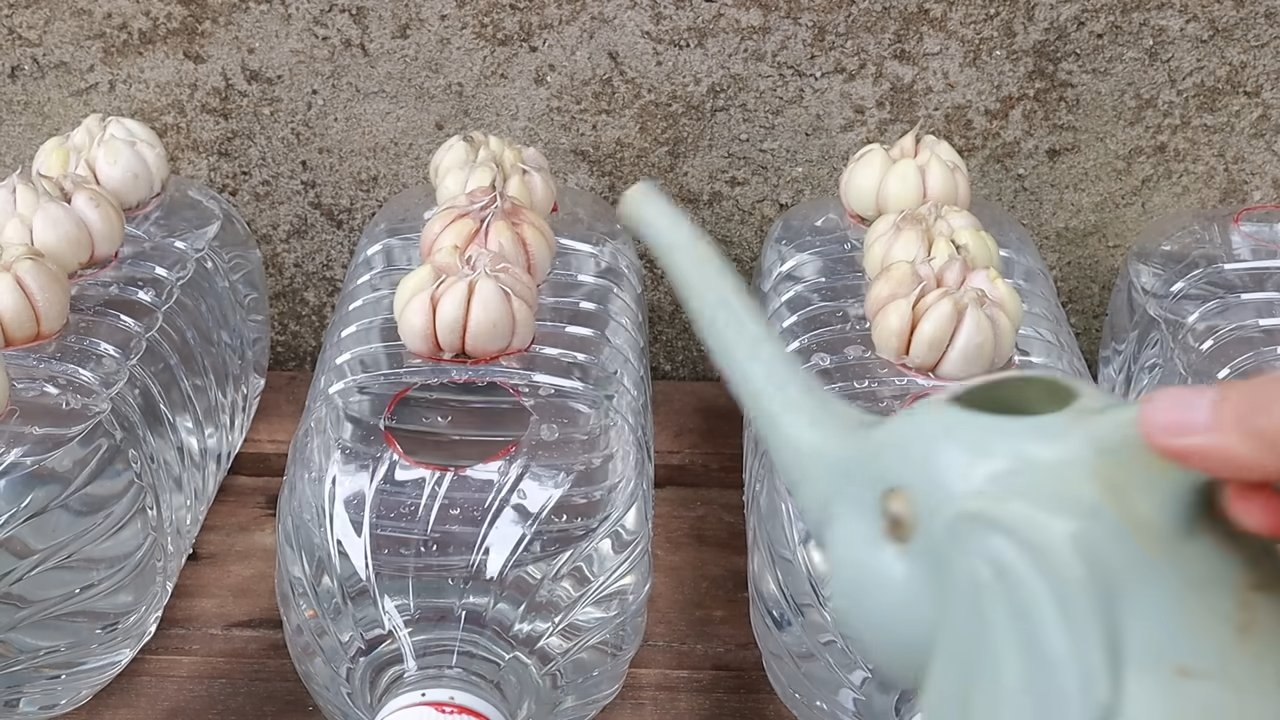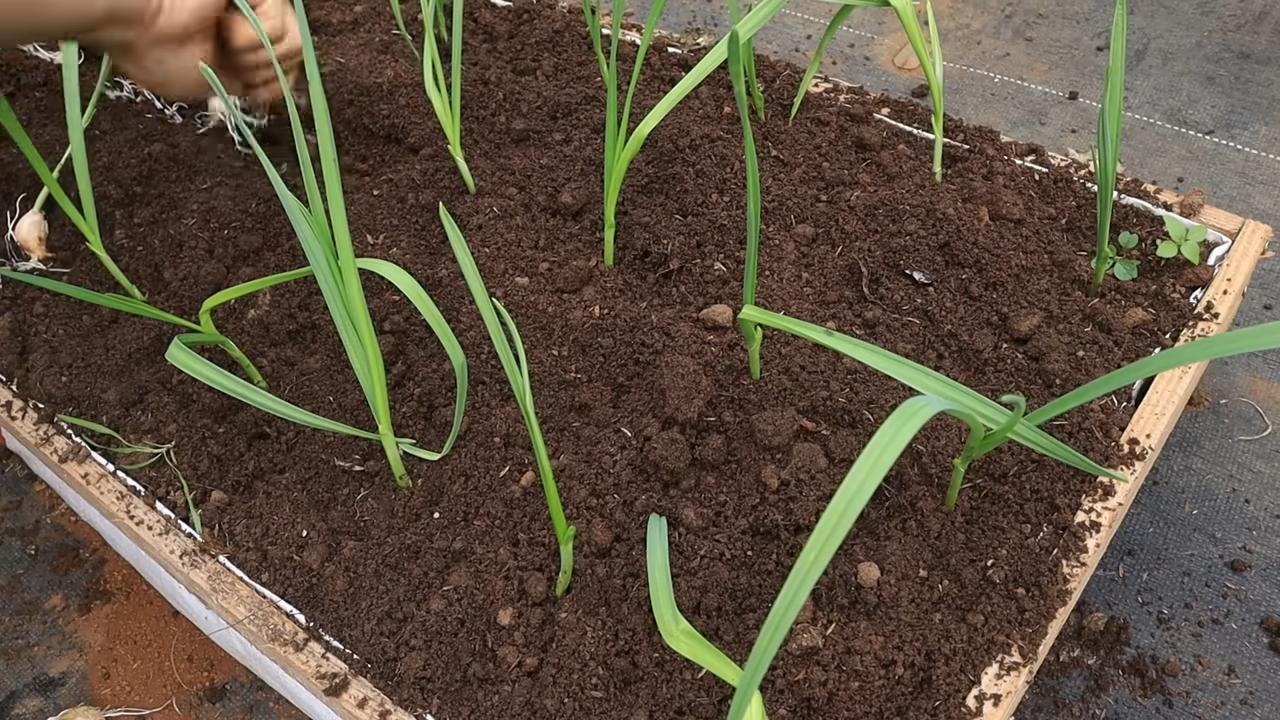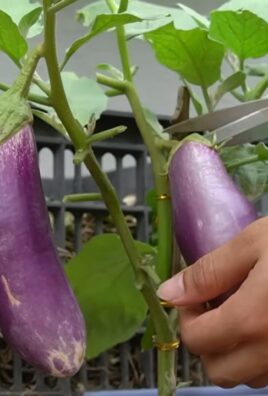Growing Garlic Indoors might seem like a challenge reserved for seasoned gardeners with sprawling outdoor plots, but I’m here to tell you it’s totally achievable – even if your “garden” is currently limited to a sunny windowsill! Forget those pricey supermarket cloves; imagine the satisfaction of harvesting your own fresh, pungent garlic right from your kitchen.
Garlic, with its rich history dating back thousands of years, has been cultivated for both culinary and medicinal purposes across numerous cultures. From ancient Egypt, where it fueled the pyramid builders, to traditional Chinese medicine, garlic has always been revered for its potent properties. Now, you can bring that ancient power into your home, regardless of your outdoor space!
Why should you try growing garlic indoors? Well, for starters, it’s incredibly rewarding! Plus, having fresh garlic readily available elevates any dish. But more importantly, it’s a fantastic way to connect with nature, even in the smallest of apartments. This DIY guide will walk you through every step, from choosing the right cloves to ensuring a bountiful harvest. I’ll share my favorite tips and tricks for growing garlic indoors successfully, so you can enjoy the delicious flavor and health benefits of homegrown garlic year-round. Let’s get started!

Growing Garlic Indoors: A Comprehensive DIY Guide
Hey there, fellow gardening enthusiasts! Ever thought about growing garlic indoors? It’s totally doable, and honestly, it’s a rewarding experience. Imagine having fresh garlic right at your fingertips, no matter the season! I’m going to walk you through everything you need to know to successfully grow garlic indoors. Let’s get started!
Choosing the Right Garlic
First things first, you need to pick the right garlic. Not all garlic is created equal, especially when it comes to indoor growing.
* Softneck vs. Hardneck: Generally, softneck varieties are better suited for indoor growing. They tend to be more adaptable to different climates and don’t require a cold period (vernalization) as strictly as hardneck varieties.
* Variety Recommendations: Look for softneck varieties like ‘California Early’ or ‘Silverskin’. These are known for their ease of growth and delicious flavor.
* Source Matters: Get your garlic from a reputable source, like a local nursery or a trusted online seed supplier. Avoid using garlic from the grocery store, as it may have been treated to prevent sprouting.
Materials You’ll Need
Okay, now let’s gather our supplies. Here’s a list of everything you’ll need to get started:
* Garlic Cloves: Choose plump, healthy cloves from your selected garlic bulb.
* Potting Mix: Use a high-quality, well-draining potting mix. Avoid using garden soil, as it can compact and not drain properly in containers.
* Pots: Select pots that are at least 6-8 inches deep and wide. Garlic needs room for its roots to grow. You can plant multiple cloves in a larger pot, spacing them about 4-6 inches apart.
* Watering Can: For gentle and even watering.
* Grow Lights (Optional but Recommended): If you don’t have a sunny spot, grow lights will be your best friend.
* Fertilizer (Optional): A balanced liquid fertilizer can help boost growth.
* Spray Bottle: For misting the soil surface.
Planting Your Garlic
Alright, let’s get our hands dirty! This is where the magic happens.
1. Prepare the Pot: Fill your pot with potting mix, leaving about an inch of space at the top.
2. Planting the Cloves: Separate the cloves from the garlic bulb, being careful not to damage them. Plant each clove pointy-side up, about 2 inches deep. Space them 4-6 inches apart if planting multiple cloves in the same pot.
3. Watering: Gently water the soil until it’s evenly moist but not soggy.
4. Placement: Place the pot in a sunny location that receives at least 6 hours of direct sunlight per day. If you don’t have enough natural light, use grow lights.
Caring for Your Indoor Garlic
Now that your garlic is planted, it’s time to nurture it. Here’s what you need to do to keep your garlic happy and healthy:
* Watering: Water regularly, keeping the soil consistently moist but not waterlogged. Check the soil moisture by sticking your finger about an inch deep. If it feels dry, it’s time to water.
* Lighting: Ensure your garlic receives adequate light. If using grow lights, position them about 6-12 inches above the plants and keep them on for 14-16 hours per day.
* Fertilizing (Optional): If you choose to fertilize, use a balanced liquid fertilizer diluted to half strength. Apply it every 2-4 weeks during the growing season.
* Temperature: Garlic prefers cooler temperatures, ideally between 60-70°F (15-21°C).
* Pest Control: Keep an eye out for pests like aphids or spider mites. If you spot any, treat them with insecticidal soap or neem oil.
* Cutting Scapes (If Applicable): If you’re growing a hardneck variety indoors (though less common), you might see scapes (the flower stalks) emerge. Cutting these off encourages the plant to put more energy into bulb development.
Harvesting Your Indoor Garlic
The moment we’ve all been waiting for! Harvesting your homegrown garlic is super satisfying.
* When to Harvest: Your garlic will be ready to harvest when the leaves start to turn yellow and brown. This usually takes about 7-8 months from planting.
* How to Harvest: Gently loosen the soil around the garlic bulb and carefully pull it out.
* Curing: After harvesting, you’ll need to cure your garlic. This involves drying the bulbs to improve their storage life.
1. Clean the bulbs by gently brushing off any excess soil.
2. Hang the garlic bulbs in a well-ventilated, dry, and dark place for 2-3 weeks.
3. Once the outer skins are dry and papery, and the necks are tight, your garlic is cured.
* Storing: Store your cured garlic in a cool, dry, and dark place. Braiding the garlic is a traditional way to store it, but you can also store it in a mesh bag or basket.
Troubleshooting Common Issues
Even with the best care, you might encounter some challenges. Here are a few common issues and how to address them:
* Yellowing Leaves: This could be due to overwatering, underwatering, or nutrient deficiencies. Adjust your watering schedule and consider fertilizing.
* Slow Growth: This could be due to insufficient light or poor soil. Ensure your garlic is getting enough light and that your potting mix is well-draining.
* Pests: As mentioned earlier, keep an eye out for pests and treat them promptly with insecticidal soap or neem oil.
* Mold: If you notice mold on the soil surface, it could be due to overwatering or poor ventilation. Reduce watering and improve air circulation.
Tips for Success
Here are a few extra tips to help you succeed in growing garlic indoors:
* Rotate Your Crops: If you’re growing garlic in the same pots year after year, consider rotating your crops to prevent soilborne diseases.
* Use a Soil Thermometer: A soil thermometer can help you monitor the soil temperature and ensure it’s within the ideal range for garlic growth.
* Don’t Overcrowd: Give your garlic plants enough space to grow. Overcrowding can lead to poor air circulation and increased risk of disease.
* Be Patient: Growing garlic takes time, so be patient and don’t get discouraged if you don’t see results immediately.
Section: Enhancing Growth with Companion Planting
Companion planting can be a fantastic way to boost the health and productivity of your indoor garlic. Certain plants can deter pests, improve soil conditions, or even enhance the flavor of your garlic.
* Chamomile: Chamomile is known to improve the overall health of plants and can deter pests.
* Marigolds: Marigolds are excellent at repelling nematodes and other soil pests.
* Nasturtiums: Nasturtiums attract aphids away from your garlic, acting as a trap crop.
* Dill: Dill can attract beneficial insects that prey on pests.
You can plant these companions in the same pot as your garlic or in nearby pots. Just be mindful of spacing and ensure that each plant has enough room to grow.
Section: Utilizing Garlic Greens
Did you know you can also harvest and use the garlic greens (the leaves) while your garlic is growing? This is a great way to get a taste of your harvest before the bulbs are fully mature.
* When to Harvest: You can start harvesting garlic greens when they are about 6-8 inches tall.
* How to Harvest: Use scissors to snip off the greens, leaving at least a few inches of growth so the plant can continue to thrive.
* How to Use: Garlic greens have a mild garlic flavor and can be used in salads, soups, stir-fries, or as a garnish.
Harvesting garlic greens won’t significantly impact the bulb’s growth, but avoid over-harvesting, as this can weaken the plant.
Section: Dealing with Limited Sunlight
If you’re struggling with limited sunlight, don’t worry! There are ways to compensate and still grow healthy garlic indoors.
* Grow Lights: Invest in high-quality grow lights. LED grow lights are energy-efficient and provide the full spectrum of light that plants need.
* Reflective Surfaces: Use reflective surfaces like mirrors or white walls to bounce light back onto your plants.
* Rotate Your Plants: Rotate your plants regularly to ensure that all sides receive adequate light.
* Choose the Right Location: Even if you don’t have a sunny window, try to find the brightest spot in your home.
By implementing these

Conclusion
So, there you have it! Growing garlic indoors is not only possible, but it’s also a surprisingly rewarding experience. From the satisfying process of watching those first green shoots emerge to the eventual harvest of flavorful scapes and bulbs, this DIY project offers a unique connection to your food and a touch of green to your indoor space, even during the coldest months.
Why is this a must-try? Because it’s more than just growing garlic; it’s about reclaiming control over your food source, reducing your reliance on store-bought produce, and adding a burst of fresh, homegrown flavor to your culinary creations. Imagine the satisfaction of using garlic you nurtured from clove to bulb in your favorite pasta sauce, stir-fry, or homemade bread. The taste difference is remarkable, and the knowledge that you grew it yourself makes it even more special.
Beyond the practical benefits, growing garlic indoors is also a fantastic way to brighten up your home and add a touch of nature to your living space. The vibrant green shoots are a welcome sight, especially during the winter months when outdoor gardens are dormant. It’s a simple yet effective way to boost your mood and create a more inviting and welcoming atmosphere.
Looking for variations? Consider experimenting with different varieties of garlic to discover your favorite flavor profiles. Softneck varieties like Artichoke garlic are well-suited for braiding, while hardneck varieties like Rocambole offer a more intense, spicy flavor. You can also try growing garlic in different types of containers, from traditional pots to repurposed jars or even hydroponic systems. The possibilities are endless!
Another fun variation is to focus solely on growing garlic greens. These tender shoots have a mild garlic flavor and can be snipped and used like chives in salads, soups, and other dishes. This is a great option if you’re short on space or simply want to enjoy the fresh flavor of garlic without waiting for the bulbs to mature.
Don’t be intimidated by the process. Growing garlic indoors is relatively easy, even for beginners. With a little patience, attention, and the right conditions, you can successfully grow your own garlic and enjoy the many benefits it offers.
We wholeheartedly encourage you to give this DIY trick a try. It’s a fun, rewarding, and delicious way to connect with nature and enhance your culinary experiences. And most importantly, we want to hear about your experience! Share your photos, tips, and stories with us in the comments below. Let’s create a community of indoor garlic growers and inspire others to embrace the joys of homegrown food. What are you waiting for? Get planting and discover the magic of growing garlic indoors!
Frequently Asked Questions (FAQ)
What kind of garlic should I use for indoor growing?
The best type of garlic for indoor growing depends on your goals and preferences. Softneck varieties, like Artichoke garlic, are generally easier to grow indoors and produce larger bulbs. They are also well-suited for braiding the leaves after harvesting. Hardneck varieties, such as Rocambole or Porcelain garlic, offer a more intense flavor and produce scapes (the curly flower stalks) which are delicious when stir-fried or used in pesto. Elephant garlic, while technically a leek, can also be grown indoors and produces very large, mild-flavored cloves. Consider your climate and the space you have available when choosing a variety. If you’re primarily interested in garlic greens, any variety will work well.
How much sunlight does indoor garlic need?
Garlic needs at least 6-8 hours of direct sunlight per day to thrive. If you don’t have a sunny window, you can supplement with grow lights. Position the lights about 6-12 inches above the plants and keep them on for 12-14 hours per day. Rotate the plants regularly to ensure even light exposure. Insufficient light can result in weak, leggy growth and smaller bulbs.
What kind of soil is best for growing garlic indoors?
Use a well-draining potting mix that is rich in organic matter. A mix of equal parts potting soil, compost, and perlite or vermiculite is ideal. Avoid using garden soil, as it can be too heavy and may contain pests or diseases. Good drainage is crucial to prevent root rot, which is a common problem with indoor plants.
How often should I water my indoor garlic?
Water your garlic when the top inch of soil feels dry to the touch. Avoid overwatering, as this can lead to root rot. Water deeply, allowing the excess water to drain out of the bottom of the pot. Reduce watering during the dormant period (after the leaves have died back).
When and how do I harvest my indoor garlic?
You can harvest garlic greens at any time by snipping off the leaves as needed. For garlic scapes (if you’re growing a hardneck variety), harvest them when they curl into a complete loop. To harvest the bulbs, wait until the leaves have turned yellow and brown and begin to die back. This usually takes about 8-9 months. Gently dig up the bulbs and allow them to cure in a dry, well-ventilated place for 2-3 weeks before storing.
Can I grow garlic indoors year-round?
Yes, you can grow garlic indoors year-round, but it’s important to provide a dormant period. After harvesting the bulbs, allow the soil to dry out completely and store the pot in a cool, dark place for 1-2 months. This mimics the natural winter dormancy that garlic requires. After the dormant period, you can replant the cloves and start the growing cycle again.
My garlic leaves are turning yellow. What’s wrong?
Yellowing leaves can be caused by several factors, including overwatering, underwatering, nutrient deficiencies, or pests. Check the soil moisture and adjust your watering accordingly. If the soil is consistently wet, reduce watering. If the soil is dry, water more frequently. You can also fertilize your garlic with a balanced liquid fertilizer to provide essential nutrients. Inspect the leaves for pests, such as aphids or spider mites, and treat them accordingly.
How do I deal with pests on my indoor garlic?
Common pests that can affect indoor garlic include aphids, spider mites, and whiteflies. You can control these pests by spraying the plants with insecticidal soap or neem oil. You can also try wiping the leaves with a damp cloth to remove the pests manually. Regularly inspect your plants for signs of infestation and take action promptly to prevent the pests from spreading.
Can I grow garlic from store-bought cloves?
Yes, you can grow garlic from store-bought cloves, but it’s best to use organic garlic to avoid any potential diseases or treatments that may inhibit growth. Choose firm, healthy cloves that are free from blemishes or soft spots. Keep in mind that store-bought garlic may not be the best variety for your climate, so the results may vary.
What are garlic scapes and how do I use them?
Garlic scapes are the curly flower stalks that grow from hardneck garlic varieties. They have a mild garlic flavor and can be used in a variety of culinary applications. You can stir-fry them, grill them, add them to pesto, or use them to flavor soups and sauces. Harvest the scapes when they curl into a complete loop for the best flavor and texture. Removing the scapes also encourages the plant to put more energy into bulb development.




Leave a Comment